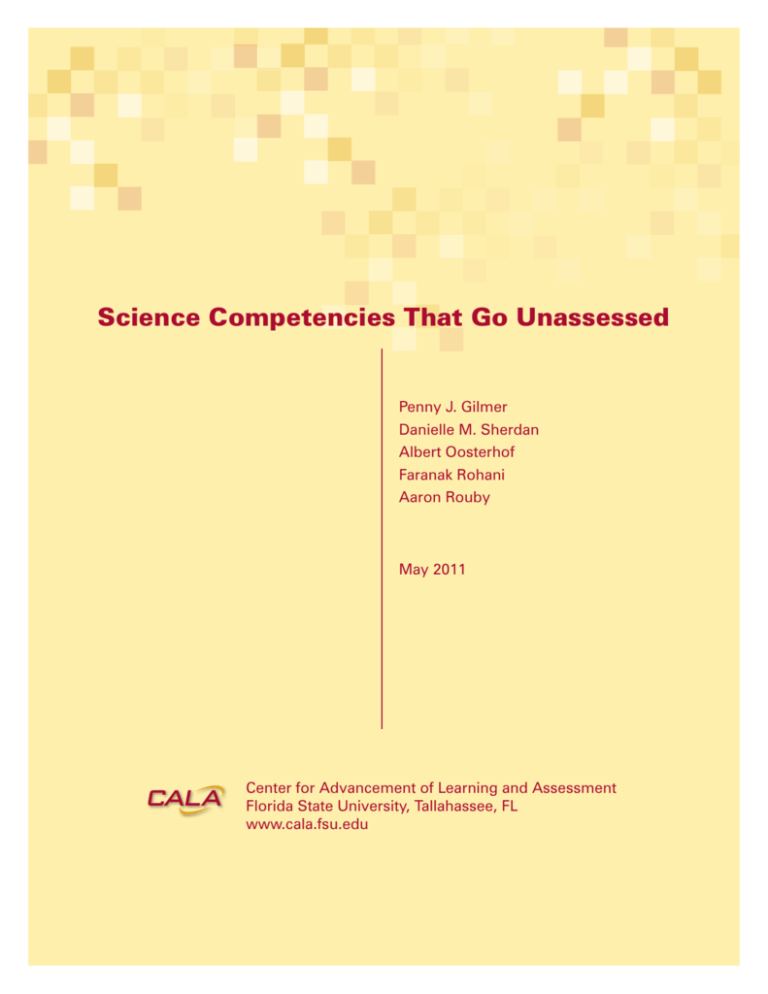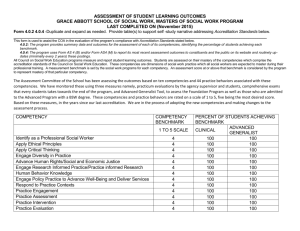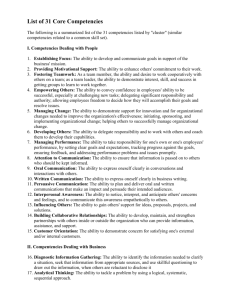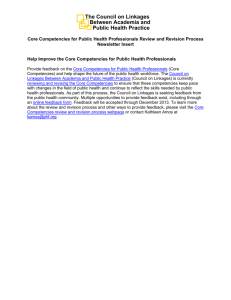
Science Competencies That Go Unassessed
Penny J. Gilmer
Danielle M. Sherdan
Albert Oosterhof
Faranak Rohani
Aaron Rouby
May 2011
194
131
Center for Advancement of Learning and Assessment
secondary colors
Florida
State University, Tallahassee, FL
1245
www.cala.fsu.edu
1205
Acknowledgments
The work reported in this paper is supported through a grant from Education Research Programs
at the Institute of Education Sciences (IES), award number R305A110121, administered by the U.S.
Department of Education. Faranak Rohani is the principal investigator for this research. Related
information is available at http://cala.fsu.edu/ies/. Findings and opinions do not reflect the positions
or policies of IES or the U.S. Department of Education.
Copyright © 2011 by the Center for Advancement of Learning and Assessment, Florida
State University. All rights reserved.
2
Science Competencies That Go Unassessed1
Penny J. Gilmer and Danielle M. Sherdan
Albert Oosterhof, Faranak Rohani, and Aaron Rouby
Florida State University
High-stakes tests, such as many statewide educational assessments, measure only a subset of
competencies associated with curriculum standards. In large part, this is a result of constraints
associated with multiple-choice and the other item formats typically used with these assessments.
Although these item formats can present fairly sophisticated tasks, many cognitively complex
competencies require alternative formats such as performance assessments.
The present paper lists important science competencies that go unassessed by statewide tests. Our
context is Florida’s present curriculum standards, referred to as the Next Generation Sunshine State
Standards. The Florida Comprehensive Achievement Test (FCAT) is used to assess the standards.
Florida’s standards are presented as benchmarks. The focus of our work is on Grade 7 science
benchmarks, which are grouped within the following “big ideas” across four Body of Knowledge
areas:
Body of Knowledge
Nature of Science
Big Idea
1: The Practice of Science
2: The Characteristics of Scientific Knowledge
3: The Role of Theories, Laws, Hypotheses,
and Models
Earth and Space Science
6: Earth Structures
Physical Science
10:Forms of Energy
11:Energy Transfer and Transformations
Life Science
15: Diversity and Evolution of Living Organisms
16: Heredity and Reproduction
17: Interdependence
Within this paper, a competency refers to a description of a particular mental ability or skill
students are expected to learn. Sometimes a benchmark explicitly states the ability or skill, although
typically it is implied. In either case, competencies represent the set of mental abilities and skills that
students must acquire to meet the curriculum standards set within a particular domain at a particular
grade level.
The work reported in this paper is supported through a grant from Education Research Programs at the Institute of
Education Sciences (IES), award number R305A110121, administered by the U.S. Department of Education. Faranak
Rohani is the principal investigator for this research. Related information is available at http://cala.fsu.edu/ies/. Findings
and opinions do not reflect the positions or policies of IES or the U.S. Department of Education.
1
3
Because competencies refer to students’ mental abilities and skills—their thought processes—
competencies cannot be directly observed. Whereas competencies exist within the mind of the
student, directly observable evidence related to the degree to which a student possesses a particular
competency must be established to infer competence. This evidence is derived from students’ performances on an assessment task. Thus, the directly observable evidence, derived from a specific task,
provides the basis for making an inference about the degree to which students possess a particular
competency.
A task is then the specific test item or performance assessment through which evidence pertaining
to student competencies can be derived. A task encompasses the specifics of an assessment, such as
the materials and stimuli presented to students, the questions or problems posed to students, and the
responses or work products that students must produce in the context of the assessment.
From the following list of competencies, our next step is to identify examples of evidence that
indicate the degree to which students possess particular competencies, and describe specific tasks for
students to perform to establish this evidence. This evidence and related tasks will be developed for
only selected competencies listed here. The others are presently assessable with FCAT-like tests.
Again, the assessment of those competencies listed below is beyond the reach of tests similar to
the FCAT. Although the competencies reference Grade 7 science benchmarks within Florida’s Next
Generation Sunshine State Standards, similar competencies are likely implicit in the middle-school
science standards that are used by other states. As with the FCAT, it is anticipated similar competencies are beyond what can be measured by the various tests presently used in statewide assessments of
science standards. To the degree that these competencies are essential, their exclusion from statewide
assessments is detrimental.
4
Nature of Science
Big Idea 1: The Practice of Science
A. Scientific inquiry is a multifaceted activity. The processes of science include the
formulation of scientifically investigable questions, construction of investigations
into those questions, the collection of appropriate data, the evaluation of the
meaning of those data, and the communication of this evaluation.
B. The processes of science frequently do not correspond to the traditional
portrayal of “the scientific method.”
C. Scientific argumentation is a necessary part of scientific inquiry and plays an
important role in the generation and validation of scientific knowledge.
D. Scientific knowledge is based on observation and inference; it is important to
recognize that these are very different things. Not only does science require
creativity in its methods and processes, but also in its questions and
explanations.
Benchmark
SC.7.N.1.1: Define a problem from
the seventh grade curriculum, use
appropriate reference materials to
support scientific understanding, plan
and carry out scientific investigation
of various types, such as systematic
observations or experiments, identify
variables, collect and organize data,
interpret data in charts, tables, and
graphics, analyze information, make
predictions, and defend conclusions.
Competencies That Go Unassessed
• Student can conduct a scientific
investigation consisting of the
following subcompetencies:
• Student can formulate a scientifically testable question(s) that
relates to the context or data
provided.
• Student can create a plan for
carrying out a scientific investigation, including what, when, and
how to measure variables.
• Student can carry out a plan for
scientific investigations of various
types.
• Student can organize data by
creating a table, chart, or other
representation to facilitate interpretation.
• Student can make inferences and
predictions and use the data to
defend or refute conclusion.
5
Benchmark
Competencies That Go Unassessed
SC.7.N.1.2: Differentiate replication
(by others) from repetition (multiple
trials).
Assessable with FCAT-like tests
SC.7.N.1.3: Distinguish between an
experiment (which must involve the
identification and control of variables)
and other forms of scientific investigation and explain that not all
scientific knowledge is derived from
experimentation.
Assessable with FCAT-like tests
SC.7.N.1.4: Identify test variables
(independent variables) and outcome
variables (dependent variables) in an
experiment.
Assessable with FCAT-like tests
SC.7.N.1.5: Describe the methods
used in the pursuit of a scientific
explanation as seen in different fields
of science such as biology, geology,
and physics.
• Student can explain that different
methods are used to investigate
scientific questions in various
fields of science.
SC.7.N.1.6: Explain that empirical
evidence is the cumulative body
of observations of a natural
phenomenon on which scientific
explanations are based.
• Student can explain that data
obtained through a scientific investigation are empirical.
SC.7.N.1.7: Explain that scientific
knowledge is the result of a great deal
of debate and confirmation within the
science community.
• Student can develop an explanation of the process by which
scientists confirm and debate each
other’s methods, data, and conclusions, which can include replication, alternative methods for investigating the same question, and
reanalysis of existing data sets.
• Student can give examples of and
describe methods used in each of
the fields of biology, geology, and
physics.
• Student can explain that empirical
data are used to scientifically
explain the natural world.
6
Big Idea 2: The Characteristics of Scientific Knowledge
A. Scientific knowledge is based on empirical evidence, and is appropriate for
understanding the natural world, but it provides only a limited understanding of
the supernatural, aesthetic, or other ways of knowing, such as art, philosophy, or
religion.
B. Scientific knowledge is durable and robust, but open to change.
C. Because science is based on empirical evidence it strives for objectivity, but as it
is a human endeavor the processes, methods, and knowledge of science include
subjectivity, as well as creativity and discovery.
Benchmark
SC.7.N.2.1: Identify an instance
from the history of science in which
scientific knowledge has changed
when new evidence or new interpretations are encountered.
Competencies That Go Unassessed
Assessable with FCAT-like tests,
assuming that students are being
asked to distinguish between
instances/noninstances of new
knowledge that changed a scientific
paradigm
7
Big Idea 3: The Role of Theories, Laws, Hypotheses, and Models
A. The terms that describe examples of scientific knowledge, for example; “theory,”
“law,” “hypothesis,” and “model” have very specific meanings and functions
within science.
Benchmark
SC.7.N.3.1: Recognize and explain
the difference between theories and
laws and give several examples of
scientific theories and the evidence
that supports them.
Competencies That Go Unassessed
• Student can explain the difference
between theories and laws.
• Student can provide examples of
scientific theories.
• Student can explain why an
example constitutes a scientific
theory.
• Student can provide examples of
evidence that support a scientific
theory.
SC.7.N.3.2: Identify the benefits and
limitations of the use of scientific
models.
Assessable with FCAT-like tests
8
Earth and Space Science
Big Idea 6: Earth Structures
A. Over geologic time, internal and external sources of energy have continuously
altered the features of Earth by means of both constructive and destructive
forces. All life, including human civilization, is dependent on Earth’s internal and
external energy and material resources.
Benchmark
Competencies That Go Unassessed
SC.7.E.6.1: Describe the layers of the
solid Earth, including the lithosphere,
the hot convecting mantle, and the
dense metallic liquid and solid cores.
Assessable with FCAT-like tests
SC.7.E.6.2: Identify the patterns
within the rock cycle and relate them
to surface events (weathering and
erosion) and subsurface events (plate
tectonics and mountain building).
Assessable with FCAT-like tests
SC.7.E.6.3: Identify current methods
for measuring the age of Earth and its
parts, including the law of superposition and radioactive dating.
Assessable with FCAT-like tests
SC.7.E.6.4: Explain and give
examples of how physical evidence
supports scientific theories that Earth
has evolved over geologic time due
to natural processes.
• Student can provide examples
of physical evidence and related
natural processes that support the
scientific theories that Earth has
evolved over geologic time.
• Student can explain why a specific
piece of evidence supports our
understanding of the scientific
theories that Earth has evolved
over geologic time.
9
Benchmark
Competencies That Go Unassessed
SC.7.E.6.5: Explore the scientific
theory of plate tectonics by
describing how the movement of
Earth’s crustal plates causes both
slow and rapid changes in Earth’s
surface, including volcanic eruptions,
earthquakes, and mountain building.
Assessable with FCAT-like tests
SC.7.E.6.6: Identify the impact that
humans have had on Earth, such as
deforestation, urbanization, desertification, erosion, air and water quality,
changing the flow of water.
Assessable with FCAT-like tests
SC.7.E.6.7: Recognize that heat
flow and movement of material
within Earth causes earthquakes
and volcanic eruptions, and creates
mountains and ocean basins.
Assessable with FCAT-like tests
10
Physical Science
Big Idea 10: Forms of Energy
A. Energy is involved in all physical processes and is a unifying concept in many
areas of science.
B. Energy exists in many forms and has the ability to do work or cause a change.
Benchmark
Competencies That Go Unassessed
SC.7.P.10.1: Illustrate that the sun’s
energy arrives as radiation with a
wide range of wavelengths, including
infrared, visible, and ultraviolet,
and that white light is made up of a
spectrum of many different colors.
• Student can illustrate a standing
wave of varying energy, and
therefore wavelengths.
SC.7.P.10.2: Observe and explain that
light can be reflected, refracted, and/
or absorbed.
• Student can identify and explain
when light is reflected off a
surface, refracted going through
a medium (including a prism),
and absorbed (as when meeting
something black).
SC.7.P.10.3: Recognize that light
waves, sound waves, and other
waves move at different speeds in
different materials.
• Student can demonstrate (e.g.,
by using a prism) and explain
that light is composed of various
energies (or wavelengths) that can
be separated into a rainbow of
colors.
Assessable with FCAT-like tests
Big Idea 11: Energy Transfer and Transformations
A. Waves involve a transfer of energy without a transfer of matter.
B. Water and sound waves transfer energy through a material.
C. Light waves can travel through a vacuum and through matter.
D. The Law of Conservation of Energy: Energy is conserved as it transfers from one
object to another and from one form to another.
11
Benchmark
Competencies That Go Unassessed
SC.7.P.11.1: Recognize that adding
heat to or removing heat from a
system may result in a temperature
change and possibly a change of
state.
Assessable with FCAT-like tests
SC.7.P.11.2: Investigate and describe
the transformation of energy from
one form to another.
• Student can perform an
experiment that demonstrates the
events as energy is transformed
from one form to another and can
describe these events.
SC.7.P.11.3: Cite evidence to explain
that energy cannot be created nor [or]
destroyed, only changed from one
form to another.
• Student can cite and explain
evidence of transformations
between potential and kinetic
energy.
• Student can cite and explain
evidence of energy transformation
from one form to another.
• Student can cite and explain
evidence that energy can neither
be created nor destroyed.
SC.7.P.11.4: Observe and describe
that heat flows in predictable ways,
moving from warmer objects to
cooler ones until they reach the same
temperature.
Assessable with FCAT-like tests
12
Life Science
Big Idea 15: Diversity and Evolution of Living Organisms
A. The scientific theory of evolution is the organizing principle of life science.
B. The scientific theory of evolution is supported by multiple forms of evidence.
C. Natural Selection is a primary mechanism leading to change over time in
organisms.
Benchmark
Competencies That Go Unassessed
SC.7.L.15.1: Recognize that fossil
evidence is consistent with the
scientific theory of evolution that
living things evolved from earlier
species.
Assessable with FCAT-like tests
SC.7.L.15.2: Explore the scientific
theory of evolution by recognizing
and explaining ways in which genetic
variation and environmental factors
contribute to evolution by natural
selection and diversity of organisms.
• Student can explain the ways in
which mechanisms of change (e.g.,
selection, mutation, genetic drift,
migration) in populations operate
on and contribute to variation in
populations over generations.
• Student can explain ways in which
genetic variation and environmental factors intersect to influence
survival, reproduction, and
diversity.
SC.7.L.15.3: Explore the scientific
theory of evolution by relating how
the inability of a species to adapt
within a changing environment may
contribute to the extinction of that
species.
• Student can explain that adaptations occur through natural
selection acting upon genetic
variation.
• Student can explain why a species
must continue to adapt when its
environment changes in order for
that species to continue to have an
advantage.
• Student can explain that the rate
of change in the environment and
the population together influence
whether a species survives.
13
Big Idea 16: Heredity and Reproduction
A. Reproduction is characteristic of living things and is essential for the survival of
species.
B. Genetic information is passed from generation to generation by DNA; DNA
controls the traits of an organism.
C. Changes in the DNA of an organism can cause changes in traits, and manipulation of DNA in organisms has led to genetically modified organisms.
Benchmark
Competencies That Go Unassessed
SC.7.L.16.1: Understand and explain
that every organism requires a set
of instructions that specifies its
traits, that this hereditary information (DNA) contains genes located in
the chromosomes of each cell, and
that heredity is the passage of these
instructions from one generation to
another.
Assessable with FCAT-like tests
SC.7.L.16.2: Determine the probabilities for genotype and phenotype
combinations using Punnett Squares
and pedigrees.
Assessable with FCAT-like tests
SC.7.L.16.3: Compare and contrast
the general processes of sexual
reproduction requiring meiosis
and asexual reproduction requiring
mitosis.
Assessable with FCAT-like tests
14
Benchmark
SC.7.L.16.4: Recognize and explore
the impact of biotechnology (cloning,
genetic engineering, artificial
selection) on the individual, society
and the environment.
Competencies That Go Unassessed
• Student can provide examples of
common biotechnologies, such as
cloning, genetic engineering, and
artificial selection.
• Student can explain uses and
limitations of common
biotechnologies.
• Student can explain short- and
long-term impacts (positive and
negative) of specific biotechnologies on individuals, society, and
the environment.
Big Idea 17: Interdependence
A. Plants and animals, including humans, interact with and depend upon each
other and their environment to satisfy their basic needs.
B. Both human activities and natural events can have major impacts on the
environment.
C. Energy flows from the sun through producers to consumers.
15
Benchmark
SC.7.L.17.1: Explain and illustrate
the roles of and relationships among
producers, consumers, and decomposers in the process of energy
transfer in a food web.
Competencies That Go Unassessed
• Student can create a diagram
(i.e., food web) that illustrates the
flow of energy among producers,
consumers, and decomposers within an ecosystem (e.g.,
student can create an illustration
of the flow of energy beginning
with solar energy, which is first
used by the producers, then the
consumers feed on the producers,
and ultimately, the decomposers
feed on both the producers and
consumers).
• Student can explain complex interrelationships among the various
types of organisms in a food web.
SC.7.L.17.2: Compare and contrast
the relationships among organisms
such as mutualism, predation,
parasitism, competition, and commensalism.
SC.7.L.17.3: Describe and investigate
various limiting factors in the local
ecosystem and their impact on native
populations, including food, shelter,
water, space, disease, parasitism,
predation, and nesting sites.
Assessable with FCAT-like tests
• Student can observe and describe
a local ecosystem.
• Student can determine potential
limiting factors for specified populations in a local ecosystem.
• Student can explain complex
relationships between biotic and
abiotic factors in an ecosystem.
• Student can investigate multiple
factors that impact native populations in the ecosystem.
16









